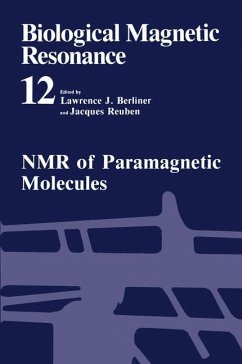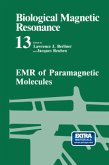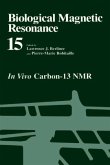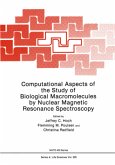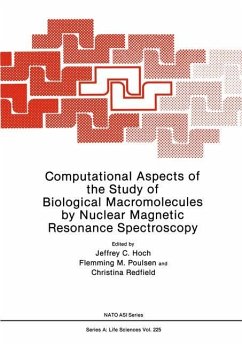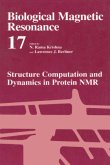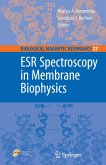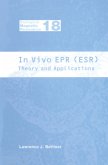NMR of Paramagnetic Molecules
Herausgegeben:Berliner, Lawrence J.; Reuben, Jacques
NMR of Paramagnetic Molecules
Herausgegeben:Berliner, Lawrence J.; Reuben, Jacques
- Broschiertes Buch
- Merkliste
- Auf die Merkliste
- Bewerten Bewerten
- Teilen
- Produkt teilen
- Produkterinnerung
- Produkterinnerung
The first of a two volume set, Volume 12 provides a long-awaited compilation of NMR theory to paramagnetic molecules. International experts report the latest developments in NMR methodology as applied to strongly relaxed and shifted resonances, detail the theoretical aspects of paramagnetic shift and relaxation, and discuss the interpretive bases of these molecular properties in relation to the structure and function of various paramagnetic molecules.
Andere Kunden interessierten sich auch für
![EMR of Paramagnetic Molecules EMR of Paramagnetic Molecules]() EMR of Paramagnetic Molecules41,99 €
EMR of Paramagnetic Molecules41,99 €![Biological Magnetic Resonance Biological Magnetic Resonance]() Lawrence J. Berliner / Pierre-Marie Robitaille (Hgg.)Biological Magnetic Resonance161,99 €
Lawrence J. Berliner / Pierre-Marie Robitaille (Hgg.)Biological Magnetic Resonance161,99 €![Computational Aspects of the Study of Biological Macromolecules by Nuclear Magnetic Resonance Spectroscopy Computational Aspects of the Study of Biological Macromolecules by Nuclear Magnetic Resonance Spectroscopy]() Jeffrey C. Hoch (Hrsg.)Computational Aspects of the Study of Biological Macromolecules by Nuclear Magnetic Resonance Spectroscopy161,99 €
Jeffrey C. Hoch (Hrsg.)Computational Aspects of the Study of Biological Macromolecules by Nuclear Magnetic Resonance Spectroscopy161,99 €![Computational Aspects of the Study of Biological Macromolecules by Nuclear Magnetic Resonance Spectroscopy Computational Aspects of the Study of Biological Macromolecules by Nuclear Magnetic Resonance Spectroscopy]() Computational Aspects of the Study of Biological Macromolecules by Nuclear Magnetic Resonance Spectroscopy161,99 €
Computational Aspects of the Study of Biological Macromolecules by Nuclear Magnetic Resonance Spectroscopy161,99 €![Structure Computation and Dynamics in Protein NMR Structure Computation and Dynamics in Protein NMR]() N. Rama Krishna / Lawrence J. Berliner (eds.)Structure Computation and Dynamics in Protein NMR242,99 €
N. Rama Krishna / Lawrence J. Berliner (eds.)Structure Computation and Dynamics in Protein NMR242,99 €![Esr Spectroscopy in Membrane Biophysics Esr Spectroscopy in Membrane Biophysics]() Marcus A. HemmingaEsr Spectroscopy in Membrane Biophysics149,99 €
Marcus A. HemmingaEsr Spectroscopy in Membrane Biophysics149,99 €![In Vivo EPR (ESR) In Vivo EPR (ESR)]() In Vivo EPR (ESR)163,99 €
In Vivo EPR (ESR)163,99 €-
-
-
The first of a two volume set, Volume 12 provides a long-awaited compilation of NMR theory to paramagnetic molecules. International experts report the latest developments in NMR methodology as applied to strongly relaxed and shifted resonances, detail the theoretical aspects of paramagnetic shift and relaxation, and discuss the interpretive bases of these molecular properties in relation to the structure and function of various paramagnetic molecules.
Produktdetails
- Produktdetails
- Biological Magnetic Resonance 12
- Verlag: Springer / Springer US / Springer, Berlin
- Artikelnr. des Verlages: 978-1-4613-6250-0
- Softcover reprint of the original 1st ed. 1993
- Seitenzahl: 456
- Erscheinungstermin: 25. Oktober 2012
- Englisch
- Abmessung: 229mm x 152mm x 25mm
- Gewicht: 656g
- ISBN-13: 9781461362500
- ISBN-10: 1461362504
- Artikelnr.: 37476342
- Herstellerkennzeichnung Die Herstellerinformationen sind derzeit nicht verfügbar.
- Biological Magnetic Resonance 12
- Verlag: Springer / Springer US / Springer, Berlin
- Artikelnr. des Verlages: 978-1-4613-6250-0
- Softcover reprint of the original 1st ed. 1993
- Seitenzahl: 456
- Erscheinungstermin: 25. Oktober 2012
- Englisch
- Abmessung: 229mm x 152mm x 25mm
- Gewicht: 656g
- ISBN-13: 9781461362500
- ISBN-10: 1461362504
- Artikelnr.: 37476342
- Herstellerkennzeichnung Die Herstellerinformationen sind derzeit nicht verfügbar.
Dr. Lawrence J. Berliner is currently Professor and Chair of the Department of Chemistry and Biochemistry at the University of Denver after retiring from Ohio State University, where he spent a 32-year career in the area of biological magnetic resonance (EPR and NMR). He is the Series Editor for Biological Magnetic Resonance, which he launched in 1979.
1 NMR Methodology for Paramagnetic Proteins.- 1. Introduction.- 2. Paramagnetic Relaxation.- 3. 1D Correlation.- 4. 2D Correlation.- References.- 2 Nuclear Relaxation in Paramagnetic Metalloproteins.- 1. Why do Nuclei Relax Faster in the Presence of Unpaired Electrons?.- 2. Correlation Time for the Nucleus-Unpaired Electron Coupling.- 3. Contributions to Nuclear Relaxation Due to Coupling with Unpaired Electrons.- 4. A Comment on Electron Relaxation Times.- 5. Electron Relaxation in Magnetic Exchange-Coupled Systems.- 6. Effect of Fast Relaxation on NOE Experiments.- 7. Effect of Fast Relaxation on 2D Experiments.- 8. General Strategy for NMR Analysis in Paramagnetic Metalloproteins.- References.- 3 Paramagnetic Relaxation of Water Protons: Effects of Nonbonded Interactions, Electron Spin Relaxation, and Rotational Immobilization.- 1. Introduction.- 2. Outersphere Relaxation.- 3. The Electron Relaxation Rate.- 4. Effects of Rotational Mobility on Solvent Relaxation.- References.- 4 Proton NMR Spectroscopy of Model Hemes.- 1. Introduction and Background.- 2. Proton NMR Studies of Various Iron Oxidation and Spin States of Porphyrins and Reduced Hemes.- 3. The Use of NMR Spectroscopy to Investigate Chemical Reactions of Model Hemes.- References.- 5 Proton NMR Studies of Selected Paramagnetic Heme Proteins.- 1. Introduction.- 2. Background.- 3. Assignments.- 4. Relative Attributes of Selected 1D and 2D Methods with CcP: Cytochrome c Complexes as Examples.- 5. Illustrative Applications.- References.- 6 Heteronuclear Magnetic Resonance: Applications to Biological and Related Paramagnetic Molecules.- 1. Introduction.- 2. 13C NMR of Paramagnetic Molecules.- References.- 7 NMR of Polymetallic Systems in Proteins.- 1. Occurrence and Role of Polymetallic Systems in BiologicalMolecules.- 2. Paramagnetism in Magnetically Coupled Systems.- 3. NMR Parameters in Exchange-Coupled Dimetallic Systems.- 4. Exploitation of Weak Exchange Coupling in Dimetallic Systems: Cu2M2 Superoxide Dismutase (M = Co, Ni).- 5. Exploitation of Strong Exchange Coupling in Dimetallic Systems: Fe2S2 Ferredoxins.- 6. Exchange-Coupled Polymetallic Systems.- 7. NMR of Fe4S4 High-Potential Iron-Sulfur Proteins.- 8. NMR of 2[Fe4S4] Ferredoxins.- 9. Cobalt(II)-Substituted Thioneins.- 10. Concluding Remarks.- References.- of Previous Volumes.
1 NMR Methodology for Paramagnetic Proteins.- 1. Introduction.- 2. Paramagnetic Relaxation.- 3. 1D Correlation.- 4. 2D Correlation.- References.- 2 Nuclear Relaxation in Paramagnetic Metalloproteins.- 1. Why do Nuclei Relax Faster in the Presence of Unpaired Electrons?.- 2. Correlation Time for the Nucleus-Unpaired Electron Coupling.- 3. Contributions to Nuclear Relaxation Due to Coupling with Unpaired Electrons.- 4. A Comment on Electron Relaxation Times.- 5. Electron Relaxation in Magnetic Exchange-Coupled Systems.- 6. Effect of Fast Relaxation on NOE Experiments.- 7. Effect of Fast Relaxation on 2D Experiments.- 8. General Strategy for NMR Analysis in Paramagnetic Metalloproteins.- References.- 3 Paramagnetic Relaxation of Water Protons: Effects of Nonbonded Interactions, Electron Spin Relaxation, and Rotational Immobilization.- 1. Introduction.- 2. Outersphere Relaxation.- 3. The Electron Relaxation Rate.- 4. Effects of Rotational Mobility on Solvent Relaxation.- References.- 4 Proton NMR Spectroscopy of Model Hemes.- 1. Introduction and Background.- 2. Proton NMR Studies of Various Iron Oxidation and Spin States of Porphyrins and Reduced Hemes.- 3. The Use of NMR Spectroscopy to Investigate Chemical Reactions of Model Hemes.- References.- 5 Proton NMR Studies of Selected Paramagnetic Heme Proteins.- 1. Introduction.- 2. Background.- 3. Assignments.- 4. Relative Attributes of Selected 1D and 2D Methods with CcP: Cytochrome c Complexes as Examples.- 5. Illustrative Applications.- References.- 6 Heteronuclear Magnetic Resonance: Applications to Biological and Related Paramagnetic Molecules.- 1. Introduction.- 2. 13C NMR of Paramagnetic Molecules.- References.- 7 NMR of Polymetallic Systems in Proteins.- 1. Occurrence and Role of Polymetallic Systems in BiologicalMolecules.- 2. Paramagnetism in Magnetically Coupled Systems.- 3. NMR Parameters in Exchange-Coupled Dimetallic Systems.- 4. Exploitation of Weak Exchange Coupling in Dimetallic Systems: Cu2M2 Superoxide Dismutase (M = Co, Ni).- 5. Exploitation of Strong Exchange Coupling in Dimetallic Systems: Fe2S2 Ferredoxins.- 6. Exchange-Coupled Polymetallic Systems.- 7. NMR of Fe4S4 High-Potential Iron-Sulfur Proteins.- 8. NMR of 2[Fe4S4] Ferredoxins.- 9. Cobalt(II)-Substituted Thioneins.- 10. Concluding Remarks.- References.- of Previous Volumes.

